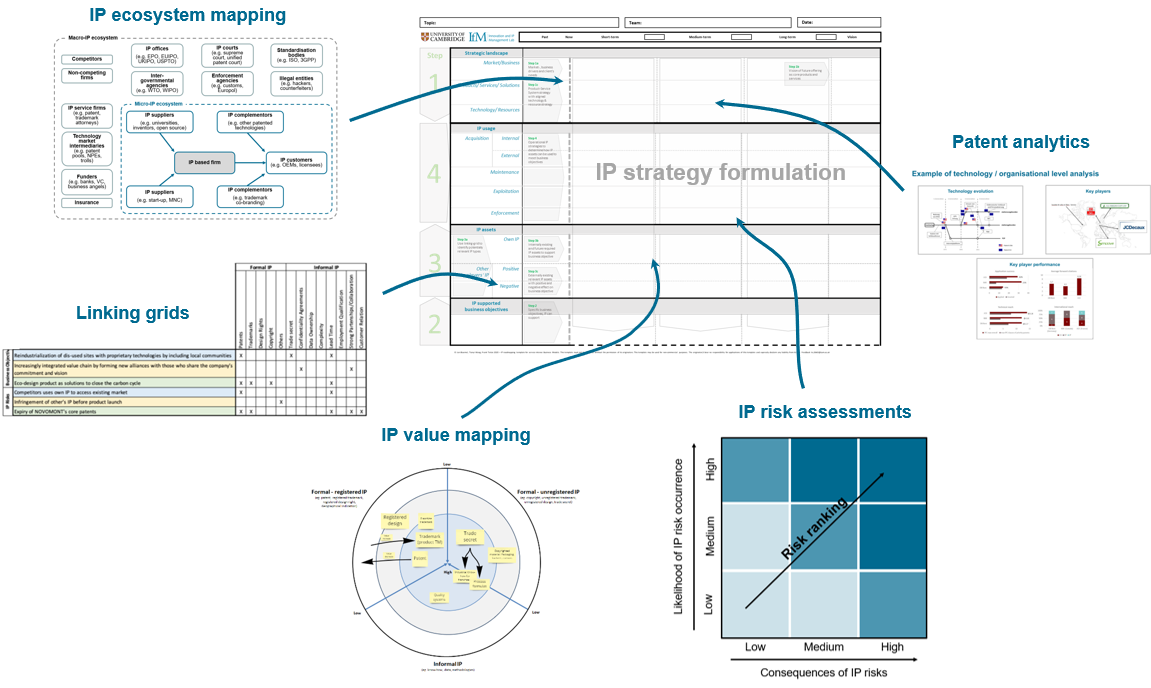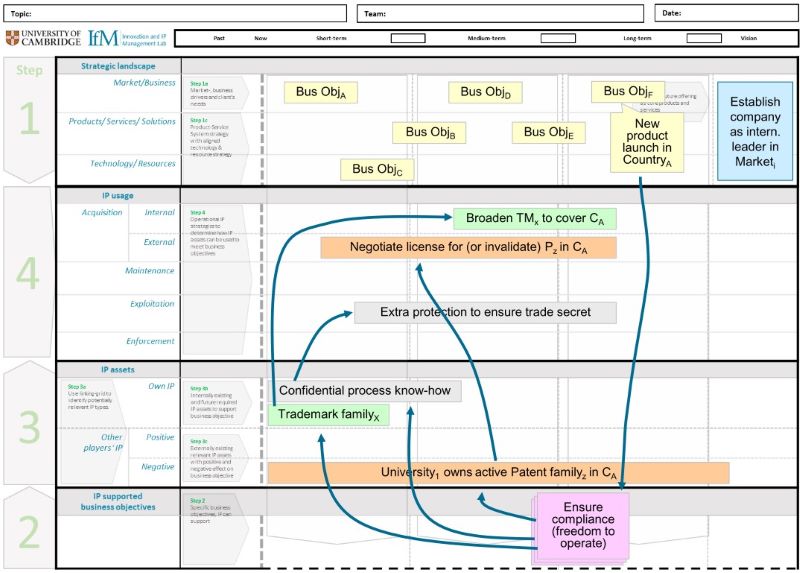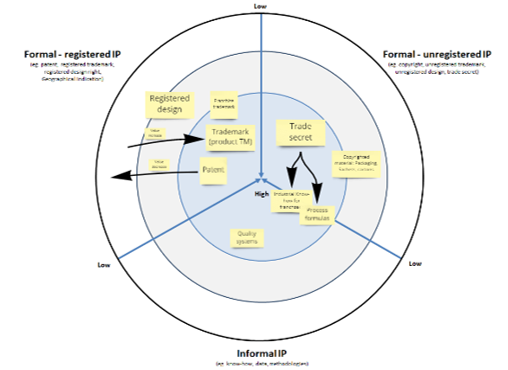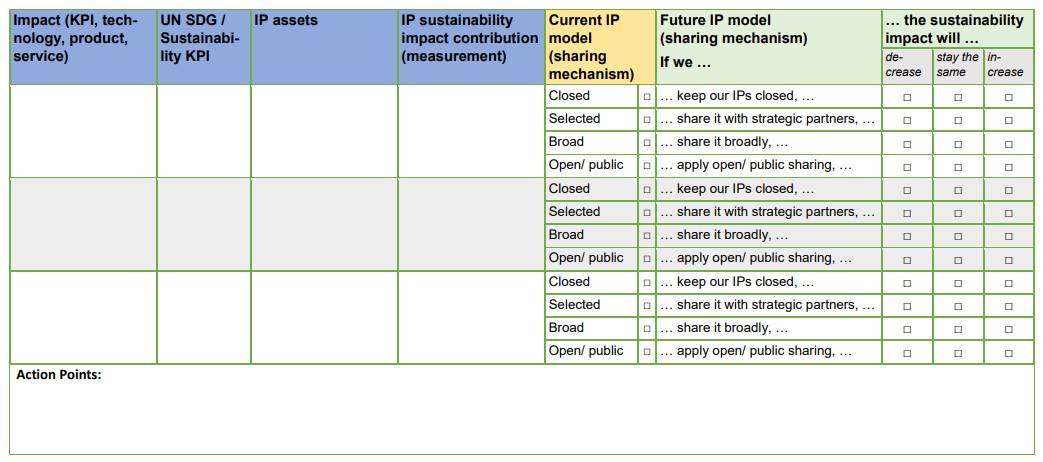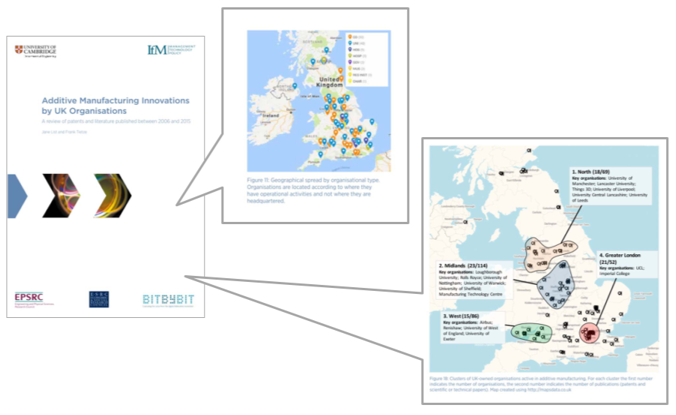While our research also focuses on fundamental (theoretical) concepts, such as strategic alignment, in the "pasteurian" spirit we also work with organisations, often using iterative, design science driven approaches to develop practically applicable tools for developing IP strategies (of which there are not very many). Doing this often then takes us back to "the drawing board", i.e. leading to ask fundamental questions.
The catalogue below provides an overview of some of the IP strategy tools that we developed over the years. In the following we provide short descriptions with snapshots of the associated visual templates, some of them with one or a few examples.
If you are interested in one or more of these tools and like to learn more about them or get our templates, please contact Prof. Tietze (frank.tietze@eng.cam.ac.uk). Several of the tools are described in articles published in academic or industrial journals, which we are happy to share with you.
Roadmapping-based IP strategy development
Roadmapping is a widely-used and well-established strategy making tool. The Centre for Technology Management (CTM) is one of the leading centres having pioneered roadmapping approaches having applied it across a wide range of industries and sectors.
Leveraging that expertise, we have developed a roadmap-based toolkit for developing IP strategies. The tool has been extensively tested and validated with large and small firms across different sectors.
The IP roadmapping toolkit is available both for “classical” in-person workshops as well as remote settings using online whiteboard tools.
On top of the generic IP roadmap approach, specialised IP roadmap processes and templates have been developed, such as for service-based business models and technology ventures.
Selected publications
Tietze, F., Phaal, R., Bluemel, J., & Wang, T. (2022). Roadmapping for formulating IP Strategies. In University of Cambridge, CTM working paper series. Cambridge, UK.
Blümel, J. H., Tietze, F., & Phaal, R. (2022). Formulating IP strategies for service-intense business models: A roadmapping-based approach. World Patent Information, 70.
IP value maps
IP value mapping is useful for reviewing IP portfolios for strategizing. It can be used to scan an organisation’s IP portfolio and identify the organisation’s most value IP assets, whether formal IP assets (e.g. patents), unregistered IP (e.g. trade secrets) or informal IP assets (e.g. datasets, algorithms).
IP ecosystem mapping
Within the IP strategy development process, it has proven to be helpful to understand the IP ecosystem that surrounds an organisation. We have developed specific templates to help facilitating this process that distinguish between the organisation’s micro ecosystem (e.g. including IP suppliers, IP customers and IP complementors) and the organisation’s wider macro IP ecosystem. Actors in that part of the ecosystem include standardisation bodies, IP service firms that need managing, other technology market intermediaries (e.g. patent pools), patent courts, IP offices and other trade/enforcement agencies.
Visual language for diagnosing IP challenges in changing ecosystems
Another mapping tool we developed is helpful for identifying ecosystem dynamics. This visual mapping tool, with an associated symbol-language allows to identify structural changes, changes to value propositions and actor relationships. In addition, this mapping tools allows for the identification of IP associated risk and opportunities between ecosystem actors.
Selected publications
Moerchel, A., Tietze, F., Aristodemou, L., & Vimalnath, P. (2022). A Novel Method for Visually Mapping Intellectual Property Risks and Uncertainties in Evolving Innovation Ecosystems: A Design Science Research Approach for the COVID-19 Pandemic. IEEE Transactions on Engineering Management, 1-13.
IP risk assessment and mitigation process
Following the convention risk management approach of identifying risks, scoring likelihood and impact of IP related events in order to then develop mitigation strategies, we developed a tool specifically for the management of IP associated risks, particularly for different risk categories, such as reputational, operational, financial and legal risks.
IP Sustainability KPI Assessment
This tool was developed to help organisations use their IP responsibly and map the use of different IP asset to sustainability KPIs, such as the UN's Sustainable Development Goals (SDGs). Further details, including the template are available for download from the IPACST project website.
IP strategy change trajectory mapping
IP strategies are not static, but evolve over time. In other words, organisations adapt their IP strategies. Based on research that studied events that trigger changes to IP strategies we developed a tool that can visually map the evolution of an organisation’s IP strategy, particularly with reference to the degree of openness that an organisation applies to when dealing with other innovation partners.
Selected publications
Tang, A., & Tietze, F. (2021). Intellectual Property Strategy Trajectory: A New Visualisation Approach. In University of Cambridge, CTM Working Paper Series. Cambridge, UK.
IP analytics
Over the years, in various research and industrial projects we have used patent (and other IP data) for different kinds of analysis. We have developed expertise with using different databases and analytical tools. Some of the analyses have been published in academic journals, e.g. with a focus on specific innovative technologies (e.g. climate technologies, additive manufacturing, care robotics), but we have also conducted geographical analyses to e.g. identify local clusters of expertise and for assessing the innovativeness of different regions.
Selected publications
List, J., & Tietze, F. (2017 ). Additive Manufacturing Innovations by UK Organisations: A review of patents and academic literature published between 2006 and 2015. Institute for Manufacturing, University of Cambridge.
We have also helped organisations developing patent indicator-based processes, such as for triaging their portfolios for identifying those with external monetization potential. Another project example includes helping a firm to develop an approach for screening patent portfolios of potential acquisition targets using a mix of a quantitative indicator and a questionnaire approach. We also possess experience with building simulation models, such as to estimate the impact of choosing different licensing models for accelerating technology commercialization against competitors.

